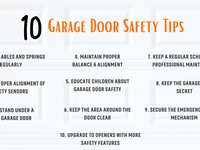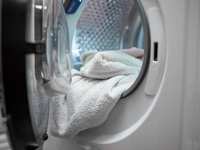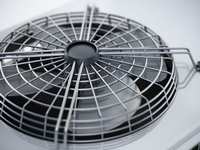- Categories :
- More
10 Important Garage Door Safety Tips Everyone Should Follow

Every time you open or close your garage door, you trust it to work safely. But what if it doesn’t? This silent, everyday machine causes 20,000 to 30,000 injuries each year in the U.S. alone. And most of those accidents are preventable by adapting garage door safety measures.
Your garage door may be the safest entry point now, but skipped maintenance and outdated parts can quickly make it a safety threat. Let’s be honest: How often do you really inspect your garage door? Most homeowners only notice it when something goes wrong, and that’s exactly when accidents happen.
Most of these injuries involve broken springs, cables, or faulty reverse mechanisms. The garage doors contain high-tension springs, powerful motors, and heavy metal parts.
Yet, many homeowners try DIY repairs and ignore serious signs of damage. They don’t realize the importance of features like the auto-reverse function. Over time, these oversights cause accidents or injuries to your loved ones.
This guide covers 10 practical, must-follow garage door safety tips that every homeowner should know. Your peace of mind is just a few safety checks away.
10 Essential Garage Door Safety Tips
1. Inspect Cables and Springs Regularly
Springs and cables both balance heavy doors for convenient operation. These parts bear the full weight of your door every time it moves. Over time, they break, fray, or rust. If a spring snaps, it can whip around with enough force to cause serious injury.
In fact, a broken torsion spring can release energy equivalent to a small explosion. Safety cable holds extension spring in case of any breakage. That’s why regular visual inspections matter. Once a month, with the door closed, take a flashlight and check:
- If the cables look worn, frayed, or slack
- If the springs are rusted, stretched, or broken
- If there’s any unusual noise when opening or closing
- Replace old spring after 7 years for their safe working
Never attempt to fix cables or springs yourself. These parts can cause damage without warning. A homeowner in Texas tried fixing a broken spring himself. The spring snapped back, hit him in the face and caused severe injuries. If anything looks off, call a certified technician.
2. Ensure Proper Alignment of Safety Sensors
Test the Auto-Reverse Feature Monthly
Your garage door has safety sensors near the bottom rails. These devices stop door closing in case of any obstacle in the path.
Sensors can lose alignment over time. A misaligned sensor can stop the door closer at all or allow it to close without detecting obstacles. Both are dangerous. Since 1991, U.S. regulations mandate that garage doors have an auto-reverse mechanism to prevent safety issues.
Test yours by placing an object under the door while closing. If it doesn’t stop, realign them. Clean the lenses as dust can block the signal. Keep them at the same height, usually 6 inches above the ground.
3. Don’t Stand Under a Moving Garage Door
Never risk walking under a 400-pound moving door even in an emergency. The door won’t stop for anyone. Or kids run beneath the door before it shuts. This is incredibly risky. A faulty door can drop suddenly and it won’t stop for anyone.
Average door weight of 130 to 150 pounds has enough pressure to cause extreme injury risk. Wait for the full closure of the door before walking through it.
Keep the Garage Door Fully Open or Closed
Leaving your garage door halfway open is not safe. Partially open doors can:
- Roll back down without warning
- Create an opportunity for break-ins
- Strain your opener and springs due to unusual tension
Children can suffer a skull fracture after being struck by a malfunctioning garage door. The accidents can be prevented with working sensors.
4. Maintain Proper Balance & Alignment
Sometimes you may notice your garage door tilts to one side when it opens? That visual flaw is a sign your door is out of balance. Let’s break down what happens:
- Motor works harder, cutting its lifespan in half.
- Cables stretch unevenly, risking one side snapping first.
- Sensors get misaligned due to jarring movement.
Here’s how to safely test the garage door balance:
- Close the garage door completely.
- Locate the bright red emergency handle and pull down firmly to detach the door from the automatic opener.
- Lift the door manually to waist height (about halfway) and let go carefully.
- If the door stays in place, your spring tension is balanced.
- If the door falls or rises on its own, the springs are out of alignment.
An unbalanced door shifts pressure to the cables, opener arm, and even the tracks. Over time, this causes cable fraying, or total system failure. Openers pulling unbalanced doors wear out 2x faster than systems with balanced spring tension.
5. Educate Children About Garage Door Safety
Kids are naturally curious about moving doors.Teach your children to not to play near or under the door. Add visual signs near the garage control panel with reminders.
Install the wall control at least 5 feet above the ground, and store remotes out of reach. If your child can press the button, they can activate the door at the wrong time.
Many accidents happen because a child accidentally hits the opener while someone is near or under the door. Newer smart openers offer mobile apps with child lock functions and are a great option for parents.
6. Keep the Area Around the Door Clear
Clutter might seem harmless but items too close to the door can block the path. Obstacles can interfere with the sensors or become tripping hazards. Bikes, storage bins, even lawn equipment should be stored away from the garage entrance.
Keeping the path clear reduces accidents and makes emergency exits faster and safer. Make it a habit to clear the path before opening or closing the door. It’s basic, but essential.
7. Keep a Regular Schedule for Professional Maintenance
Your garage door deserves the same care as your car. It’s a complex mechanical system of springs, rollers, hinges, cables, sensors, all working under tension. Many homeowners schedule maintenance until something breaks. But preventative maintenance avoids surprise failures. A technician can:
- Lubricate moving parts to reduce friction
- Check spring tension and cable integrity
- Tighten bolts and brackets that loosen over time
- Test the reverse mechanism and force settings
This will not just catch issues early but avoid dangerous ones. For example, frayed lift cables can snap suddenly, whipping around dangerously at high speed. A routine inspection could stop that hazard in its tracks.
Avoid DIY repairs on high-tension components. You can safely lubricate and clean the door parts. But leave any work involving springs, cables, or opener motors to professionals. We recommend a full safety tune-up once or twice a year if your door sees heavy use.
8. Keep the Garage Code Secret
Think of your garage code like a house key. Would you give your key to just anyone? Then don’t share your access code casually.
Modern garage openers have wireless keypads and app-controlled access. That’s easy but it also creates chances of risks. If your code is too simple (like 1234 or your address), or you’ve shared it with others, it’s time to reset it. Always:
- Use a strong, unpredictable code
- Change it periodically
- Don’t write it down in obvious places
Some break-ins happen without breaking anything. Criminals gain entry through old or shared codes. Latest opener models come with rolling code technology so make sure it is enabled. This feature changes the code automatically every time you use the remote, making hacking nearly impossible.
9. Secure the Emergency Release Mechanism
The emergency release (usually a red handle hanging from a cord) is designed to disconnect the door from the opener during power outages or mechanical failures. It’s important but it can also be a vulnerability if not secured properly.
Criminals can use a coat hanger through the top weather seal of your garage to pull that cord from outside. Door can be manually opened in a minute.
What to do:
- Add a zip tie or latch to the release mechanism to make it harder to snag from outside.
- Install a garage shield. It’s a simple plastic device that blocks access from above.
- If you rarely use the manual release, you can safely secure it and still retain emergency access with proper planning.
10. Upgrade to Openers with More Garage Door Safety Features
Openers older than 15 years lack modern safety features. Households that upgraded to smart openers reduced garage-related service calls in the first two years. This happens because of early detection alerts and better remote management.
Today’s smart garage systems offer:
- Rolling code encryption for remote access
- App control with alerts for door activity
- Self-diagnostic auto-reverse tests
- Battery backups for power outages
- Motion-detection lights for better visibility and security
Technology has evolved and safety has, too. Don’t let an outdated opener put your family or home at risk.
Final Words
Homeowners can increase garage door safety by adapting some necessary precautions. It all depends on professional maintenance and upgrading of old/outdated door parts. Most homeowners never hear these safety tips until after an accident happens. You have to adapt safety measures before a preventable issue becomes a costly emergency.
Small checks, honest upgrades, and expert care go a long way to secure your home. Our garage door professionals spot issues before they start. Every visit comes with a safety-first mindset, not just fast service. Whether it’s time for repair, installation or maintenance, we’re just a call away.












